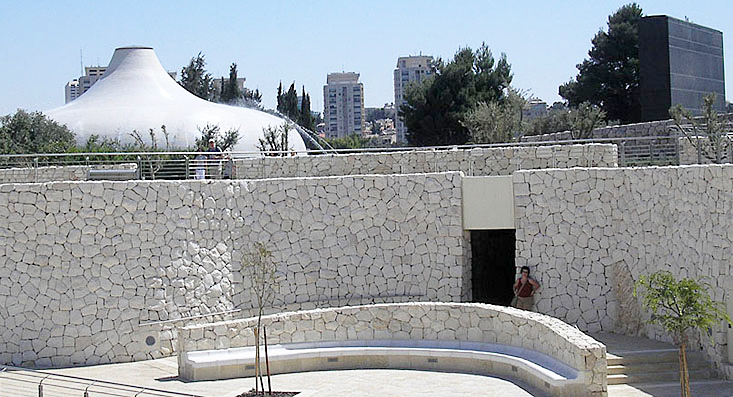
Bible, History, Archaeology
Bible,
History,
Archaeology
The Great Isaiah Scroll,
or Isaiah ( (1QIsa)
Contents:
Introduction – Copyist's modifications
Introduction
The Great Isaiah Scroll (1QIsa, a for the full-text version of the book), is certainly the most emblematic of the Qumran discoveries, as it is the best preserved and one of the oldest.
Another scroll found at Qumran preserved only 75 % of the text (b for the damaged and incomplete version).
For years, the Great Isaiah Scroll was displayed unrolled in the Israel Museum, under the white dome of the «Sanctuary of the Book». For conservation reasons, it was finally replaced by a facsimile.
 Image opposite: the Sanctuary of the Book in Jerusalem. © DR.
Image opposite: the Sanctuary of the Book in Jerusalem. © DR.
The Great Scroll is over 7 meters long. It is made up of seventeen leather sheets sewn together, with parchment lacunae in the margins, which are quite damaged, and in the text. It was certainly copied in the 2nd or 1st century BC. The text of the scroll shows few significant differences from that of today's Hebrew Bibles; these are essentially orthographic variants. As the text was not yet vocalized according to the Massoretic system that would be perfected centuries later, scribes often used Hebrew consonants, giving them a vowel value: the letter ו (waw) can be read «or» or «o»; the letter י (yod) can correspond to «i» or «é»; or the letters א (awl) or ה (hé) to «a» or «è».

Occasionally, the scribe makes a copying error. In such cases, he indicates the text to be corrected with underlined dots, and replaces it with the correct text, which he inserts above the line. A good example is column 3 (see below), where the scribe first wrote «Lord» (Hebrew adonai), then corrected by the divine name «Yhwh» (the famous tetragrammaton). The reverse occurs in the previous line (Isaiah 3:17 and 3:18).
Image opposite: a Yemeni sofer (scribe) checking a Torah passage. Library of Congress, USA.
Since the two words are spelled differently, this is not a spelling error. But for fear of using the name of God in vain (Exodus 20:7), the Jews substituted the title «Lord». Two conclusions are obvious: firstly, this manuscript must have been copied under dictation; secondly, the pronunciation «Lord» (adonai) of the tetragrammaton, thought to date back to the Middle Ages, turns out to be older than previously imagined. Once again, the Qumran manuscripts open up a whole new world of ancient Jewish traditions.
MR L.

 Image opposite: the Sanctuary of the Book in Jerusalem. © DR.
Image opposite: the Sanctuary of the Book in Jerusalem. © DR.